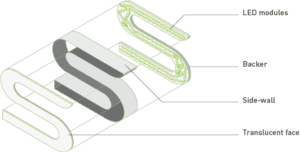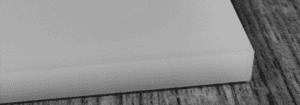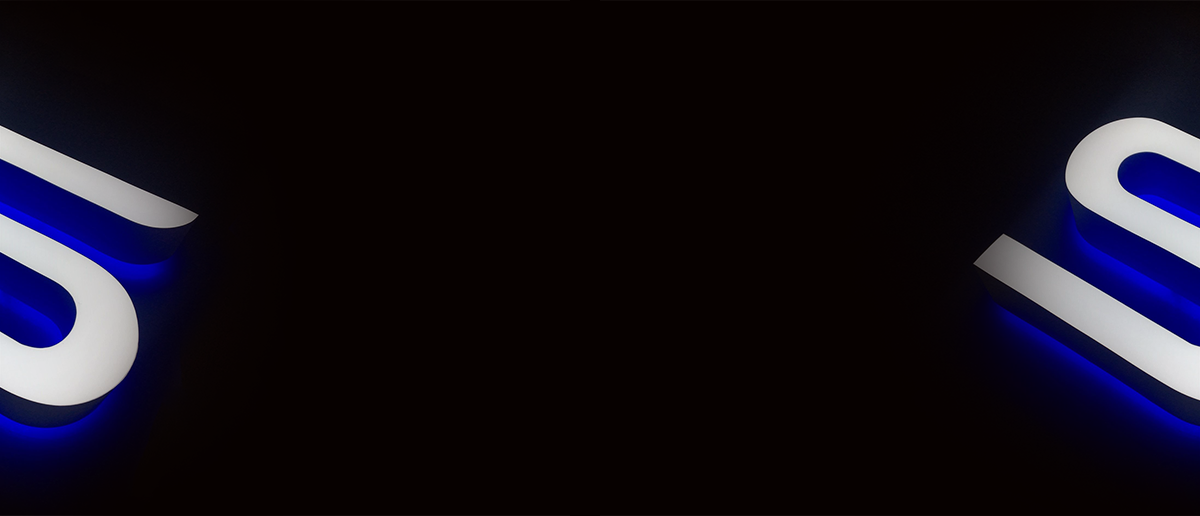Introduction:
With over 30 years of signage experience, Signwise has developed some of the best signage processes for our clients to ensure quality signage lasts as long as their brands do.
We have found in all these years that it is more cost-effective in the long run to invest in better high-quality signage that will see you through up to ten years of business than it is to deal with faulty and cheap signage that will need to be managed regularly and/or replaced.
Here are 5 things to check to ensure you are getting good quality signage that will stand the test of time:

The Side Wall Of The Fabricated Letter:
The sidewall of large letters is the sides of the 3D letter that houses the illuminated unit as shown in the diagram. There are two very important factors to check here. What is the sidewall made of and how thin is the sidewall of the light-up letter signage?
The sidewall should ideally be made of aluminium because aluminium is rust-resistant and can be more accurately bent to represent the branding correctly and optimally. Aluminium sidewalls are UV resistant which means it will not discolour, unlike the cheaper plastic or acrylic counterparts that tend to yellow and crack due to exposure. This makes aluminium sidewalls longer lasting overall and a lot more weather resistant. Aluminium also has the added advantage of being light which makes it easier and safer to install.
Although steel doesn’t have this advantage it is ok to use, but only if it is coated and doesn’t exceed the weight requirements for structural. Aesthetically, aluminium side walls simply look a lot smarter and more bespoke compared to steel or the cheaper alternatives.
Make Sure Your Signwriter is Using The Correct LEDs
LED lighting takes hundreds of different shapes and forms to serve so many purposes in today’s technology-driven world. It is important to check that the right kind of LED modules is being used for your signage so that the signage illumination lasts as long as the sign does.
Like many things in life, there are cheap low-quality options out there and this couldn’t be more true for LEDs. At Signwise we have tried and tested various brands and types of LEDs. Here are some of the things we check before fitting out the sig with LEDs:

- The International Protection Rating or IP rating is important to check because it will tell you how durable the LED modules are. While IP65 is sufficient for most signage, we use IP68 rated modules to be absolutely sure that the signage will meet our standards.
- The LM rating or Lumen Rating is the way we rate and measure the light intensity of the LED modules. This needs to fit within council requirements and we recommend consulting with your signwriter on this for any outdoor permanent illuminated signage to keep your signage compliant and shining as bright as possible at the same time.
- The Light Colour is important to check even if you are going with a standard white. As you may know, there is a spectrum of “white light” options available for LED signage illumination from warm (yellowish) light which is more suited to branded signage that needs a “homey” or “cosy” feel to stark white which is popular for corporate brands. There is also a stark blue LED light option that produces cold light which is usually only used for specific brands that need to create that kind of ambience. Additionally, there are RGB LED modules available that give you a range of colours which is also exciting to work with and adds a lot of personality and vibrance to the 3D illuminated signage.
- The Driver or Power Supply needs to be quality checked in terms of IP rating. We use Mean Well* drivers for our signs because they are the world leaders in LED drivers with the best IP rating in its category. By using only the best drivers we can ensure our standards of high durability and reliability for our clients investing in permanent building signage.
The Face Of The Sign & Light Diffusion
This part of the sign should be seamlessly fabricated. But how do you make sure your signage is passing the test in this regard?
There are three types of illuminated letter signage faces namely, sheet acrylic, liquid acrylic and PVC. It is best to consult with your signwriter on which type would best suit your project but we have outlined the main advantages of each:
- Sheet acrylic face is also great for large and small formats and tends to be more cost-effective. This option is flexible in terms of thickness and colour and is a lot more durable and UV resistant, however, it is heavy in large quantities and is limited by sheet size.

- Liquid acrylic face is used to obtain that perfect finish and is slightly less durable without a protective vinyl diffusion layer. This is our favoured option in most of our signage because it gives the 3D lettering that seamless illumination because the liquid bonds to the sidewall with no additional fixing.

- PVC face is great for very large format signage lettering (up to 8.5m tall in the case of the Kmart signage). PVC is only ever used to avoid “joins” when the letter is too big to be acrylic poured or fit any of the standard acrylic sheets. In this case, it is important to avoid digital printing as this will make the signage less durable which is a bad move when investing in this type of expensive large scale signage.

The second thing to check is whether an additional diffusion layer of translucent vinyl has been added to the face. This is very important because the LED modules have directional illumination compared to incandescent lights, fluorescence and neon which throw light in 360 degrees. This translucent diffusion layer disperses the light in a way that is a lot finer and smoother which achieves a more even illumination on your fabricated custom signage. This layer is also important as it protects the acrylic face of the 3d sign from “yellowing” in the sun over time. Additionally, this layer can come in any colour and can also be digitally printed with opens so many more doors for creativity when outlining the specifications of your bespoke illuminated signage.
How Will The Sign Be Fixed?
Is the 3D illuminated signage being installed over the cladding? This is an important question to ask because most high-quality signs are too heavy to be held in place when fixed to the cladding of a building. The sign needs to be fixed directly to the support structure behind the cladding to ensure it won’t even fall down. Often there is no allowance for signage in building construction, so having building plans is helpful.
Is the illuminated signage too heavy? At Signwise, we fabricate our signage using the lightest materials that don’t compromise the finished look. The material that works best here is aluminium. It lends a heavy metal appearance and “feel” to the finished illuminated sign without any of the actual weight added. While aluminium is an expensive material to work with it helps avoid additional costs of building more framework to support the sign and keeping installation time minimal (saving labour costs). Additionally, we can add the necessary structural soundness to the signage while minimising the cost of that using high-quality material like aluminium.
Your Free Illuminated 3D Signage Letting Checklist:
- Is the side wall made of high-quality weatherproof material?
- Are the LEDs the correct LEDs for the particular sign?
- Are the LEDs reliable and trusted?
- IP rating on LED modules and drivers.
- LM rating on LED modules and council compliance.
- Is the face of the sign evenly and smoothly poured?
- Is the face of the sign properly UV rated?
- Is the signage correctly fixed to the building?
- Is the signage too heavy to be structurally sound?


 Back
Back
